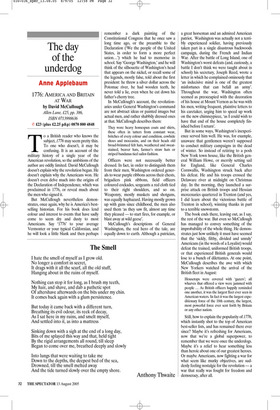The day of the underdog
Anne Applebaum
1776: AMERICA AND BRITAIN AT WAR by David McCullough Allen Lane, £25, pp. 386, ISBN 0713998636 ✆ £23 (plus £2.25 p&p) 0870 800 4848 To a British reader who knows the subject, 1776 may seem pretty thin. To one who doesn’t, it may be confusing. It is an account of the military history of a single year of the American revolution, so the ambitions of the author are oddly limited. David McCullough doesn’t explain why the revolution began. He doesn’t explain why the Americans won. He doesn’t even delve much into the origins of the Declaration of Independence, which was proclaimed in 1776, or reveal much about the men who signed it.
But McCullough nevertheless demonstrates, once again, why he is America’s bestselling historian. For his book does lend colour and interest to events that have sadly come to seem dry and dusty to most Americans. Say ‘1776’ to your average Vermonter or your typical Californian, and he will look a little blank and then perhaps remember a dark painting of the Constitutional Congress that he once saw a long time ago, or the preamble to the Declaration (‘We the people of the United States, in order to form a more perfect union...’) which he had to memorise in school. Say ‘George Washington,’ and he will think of the silhouette of Washington’s head that appears on the nickel, or recall some of the legends, mostly false, told about the first president: he threw a silver dollar across the Potomac river, he had wooden teeth, he never told a lie, even when he cut down his father’s cherry tree.
In McCullough’s account, the revolutionaries under General Washington’s command are not abstract ideas or painted images but actual men, and rather shabbily dressed ones at that. McCullough describes them:
They wore heavy homespun coats and shirts, these often in tatters from constant wear, britches of every colour and condition, cowhide shoes and moccasins, and on their heads old broad-brimmed felt hats, weathered and sweatstained, beaver hats, farmer’s straw hats or striped bandanas tied sailor-fashion.
Officers were not necessarily better dressed. In fact, in order to distinguish them from their men, Washington ordered generals to wear purple ribbons across their chests, brigadiers pink ribbons, field officers coloured cockades, sergeants a red cloth tied to their right shoulders, and so on. Weaponry, mostly muskets and shotguns, was equally haphazard. Having mostly grown up with guns since childhood, the men also used them ‘as they saw fit, almost any time they pleased — to start fires, for example, or blast away at wild geese’.
McCullough’s descriptions of General Washington, the real hero of the tale, are equally down to earth. Although a patrician, a great horseman and an admired American patriot, Washington was actually not a terribly experienced soldier, having previously taken part in a single disastrous backwoods campaign, during the French and Indian War. After the battle of Long Island, one of Washington’s worst defeats (and, curiously, a battle I don’t think we were taught about in school) his secretary, Joseph Reed, wrote a letter in which he complained ominously that ‘an indecisive mind is one of the greatest misfortunes that can befall an army’. Throughout the war, Washington often seemed as preoccupied with the decoration of his house at Mount Vernon as he was with his men, writing frequent, plaintive letters to his caretaker, urging him to speed up work on the new chimneypiece, ‘as I could wish to have that end of the house completely finished before I return’.
But in some ways, Washington’s inexperience served him well. He was, for example, unaware that gentlemen weren’t supposed to conduct military campaigns in the dead of winter. So instead of retiring to a posh New York town house, like the British general William Howe, or merrily setting sail for England, like General Charles Cornwallis, Washington struck back after his defeat. He and his troops crossed the Delaware river at midnight on Christmas day. In the morning, they launched a surprise attack on British troops and Hessian mercenaries quartered in Trenton (and yes, I did learn about the victorious battle of Trenton in school), winning thanks in part to a terrible snowstorm.
The book ends there, leaving out, as I say, the rest of the war. But even so McCullough has managed to convey something of the improbability of the whole thing. He demonstrates just how unlikely it must have seemed that the ‘sickly, filthy, divided and unruly’ Americans (in the words of a Loyalist) would defeat the trained, uniformed British troops, or that experienced British generals would lose to a bunch of dilettantes. At one point, McCullough describes the awe with which New Yorkers watched the arrival of the British fleet in August:
Housetops were covered with ‘gazers’; all wharves that offered a view were jammed with people ... As British officers happily reminded one another, it was the largest fleet ever seen in American waters. In fact it was the largest expeditionary force of the 18th century, the largest, most powerful force ever sent forth by Britain or any other nation.
Still, how to explain the popularity of 1776, which instantly shot to the top of American best-seller lists, and has remained there ever since? Maybe it’s refreshing for Americans, now that we’re a global superpower, to remember that we were once the underdogs. Maybe it’s a relief to hear something less than heroic about one of our greatest heroes. Or maybe Americans, now fighting a war for what seem like murky objectives, are suddenly feeling nostalgic for the revolution — a war that really was fought for freedom and democracy, after all.











































 Previous page
Previous page